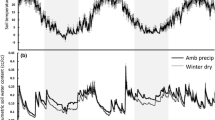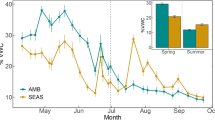Abstract
This study investigates the effects of field manipulations of local climate to determine the potential impact of climate change on plant community dynamics in a calcareous grassland. The experimental site is located in a grassland at the Wytham estate, Oxfordshire, UK. The one hectare study area is within a 10 ha abandoned arable field on Jurassic corallian limestone. Two climate change scenarios were used: warmer winters with increased summer rainfall and warmer winters with summer drought. Plant cover and species richness were significantly increased in plots receiving supplemented summer rainfall, while the amount of litter was significantly reduced. Litter formation was significantly increased by winter warming and drought. The responses of the plant community to the climate manipulations were related to the life-history attributes of the dominant species. Seedling recruitment was limited by microsite availability, which also varied in the different climate manipulations. The results are discussed in terms of successional dynamics. They suggest that warmer winters may delay succession, as gap formation in the sward will provide sites for colonisation of annuals, thereby enabling their persistence in the sward. Under wetter conditions during summer, perennial grasses tend to close the sward, thereby inhibiting the establishment of later successional species.
Similar content being viewed by others
References
Ackerley, D. D. & Bazzaz, F. A. 1995. Plant growth and reproduction along CO2gradients: non-linear responses and implications for community change. Global Change Biol. 1: 199-207.
Aguilera, M. O. & Lauenroth, W. K. 1995. Influence of gap disturbance and types of microsites on seedling establishment in Bouteloua gracilis. J. Ecol. 83: 87-97.
Alward, R. D, Detling, J. K. & Milchunas, D. G. 1999. Grassland vegetation changes and nocturnal global warming. Science 283: 229-231.
Baker, J. T., Allen Jr., L. H., Boote, K. J. & Pickering, N. B. 1997. Rice responses to drought under carbon dioxide enrichment. 1. Growth and yield. Global Change Biology 3: 119-128.
Bazzaz, F. A. 1990. The response of natural ecosystems to the rising global CO2 levels. Ann. Rev. Ecol. Syst. 21: 167-196.
Bazzaz, F. A. & Carlson, R. W. 1984. The response of plants to elevated CO2. Competition among an assemblage of annuals at two levels of soil moisture. Oecologia 64: 196-198.
Beerling, D. J. & Woodward, F. I. 1994. Climate change and the British scene. J. Ecol. 82: 391-397.
Bosy, J. L. & Reader, R. J. 1995. Mechanisms under the suppression of forb seedling emergence by grass (Poa pratensis) litter. Functional Ecology 9: 635-639.
Buckland, S. M. 1994. An investigation into the responses of limestone grassland to climatic manipulation and species introductions. Ph.D. Thesis, University of Sheffield, UK.
Campbell, B. D, Laing, W. A, Greer, D. H., Crush, J. R., Clark, H., Williamson, D. Y & Given, M. D. J. 1995. Variation in grassland populations and species and the implications for community responses to elevated CO2. J. Biogeogr. 22: 315-322.
Campbell, B. D., Stattford Smith, D. M. & Mckeon, G. M. 1997. Elevated CO2 and water supply interactions in grasslands: a pastures and rangelands management perspective. Global Change Biol. 3:177-188.
CCIRG (Climate Change Impacts Review Group), 1991. The potential effects of climate change in the United Kingdom. HMSO. London.
CCIRG (Climate Change Impacts Review Group), 1996. Review of the potential impacts of climate change in the United Kingdom. HMSO, London.
Chapin, F. S. III, Shaver, G. R., Giblin, A. E., Nadelhoffer, K. J. & Laundre, J. A. 1995. Responses of arctic tundra to experimental and observed changes in climate. Ecology 76: 694-711.
Connell, J. H. & Slatyer, R. O. 1977. Mechanisms of succession in natural communities and their role in community stability and organization. Am. Nat. 111: 1119-1144.
Couteaux, M-M., Bottner, P. & Berg, B. 1995. Litter decomposition, climate and litter quality. Trends Ecol. Evol. 10(2): 63-66.
Cummins, C. P., Beran, M. A., Bell, B. G. & Oliver, H. R. 1995. The TIGER programme. J. Biogeogr. 22: 897-905.
Facelli, J. M. & Pickett, S. T. A. 1991. Plant litter: light interception and effects on an old-field plant community. Ecology 72: 1024-1031.
Fajer, E. D., Bowers, M. D. & Bazzaz, F. A. 1989. The effects of enriched carbon dioxide atmospheres on plant-insect interactions. Science 243: 1198-1200.
Farnsworth, E. J., Nunez-Farfan, J., Careaga, S. A. & Bazzaz, F. A. 1995. Phenology and growth of three temperate forest life forms in response to artificial soil warming. J. Ecol. 83: 967-977.
Field, C., Chapin III, F. S., Matson, P. A. & Mooney, H. A. 1992. Responses of terrestrial ecosystems to the changing atmosphere: a resource-based approach. Ann. Rev. Ecol. Syst. 23: 201-236.
Grace, J. B. 1990. On the relationship between plant traits and competitive abilities. Pp. 51-65. In: Grace, J. B. & Tilman, D. (eds), Perspectives on plant competition. Academic Press. New York.
Gibson, C. W. D. 1986. Management history in relation to changes in the flora of different habitats on an Oxfordshire estate, England. Biol. Cons 38: 217-232.
Graves, J. & Reavey, D. 1996. Global environmental change. Plants, animals and communities. Longman Group Ltd., Essex.
Grime, J. P. 1979. Plant strategies and vegetation processes. John Wiley & Sons, Chichester.
Gross, K. L. & Werner, P. A. 1982. Colonisation abilities of ‘biennial’ plant species in relation to ground cover: implications for their distributions in a successional sere. Ecology 63: 921-931.
Harper, J. L. 1977. Population biology of plants. Academic Press, London.
Harte, J. & Shaw, R. 1995. Shifting dominance within a Montane vegetation community: results of a climate-warming experiment. Science 267: 876-880.
Hillier, S. H., Sutton, F. & Grime, J. P. 1994. A new technique for experimental manipulation of temperature in plant communities. Funct. Ecol. 8: 755-762.
Hirschel, G., Korner, C. & Arnone, J. A. 1997. Will rising CO2 affect leaf litter quality and in situ decomposition rates in native plant communities? Oecologia 110: 387-392.
Hobbie, S. E., Jensen, D. B. & Chapin, F. S., III. 1993. Resource supply and disturbance as controls over present and future plant diversity. Pp. 385-407. In: Schulze, E. D. & Mooney, H. A. (eds), Ecosystem function of biodiversity, Springer-Verlag, Berlin.
Hobbie, S. E. 1996. Temperature and plant species control over litter decomposition in Alaskan tundra. Ecol. Monogr. 66: 503-522.
Hobbie, S. E. & Chapin, F. S., III. 1998. The response of tundra plant biomass, aboveground production, nitrogen, and CO2 flux to experimental warming. Ecology 79: 1526-1544.
Houghton, J. T., Meira Filho, L. G., Bruce, J., Lee, H., Callander, B. A., Haites, E., Harris, E., Kattenberg, A. & Maskell, K. 1996. Climate change 1995. The science of climate change. Cambridge University Press, Cambridge.
Jamieson, N., Barraclough, D., Unkovich, M. & Monaghan, R. 1998. Soil N dynamics in a natural calcareous grassland under a changing climate. Biol. Fertility Soils 27: 267-273.
Lincoln, D. E., Fajer, E. D. & Johnson, R. H. 1993. Plant-insect herbivore interactions in elevated CO2 environments. Trends Ecol. Evol. 8: 64-68.
Lukewille, A. & Wright, R. F. 1997. Experimentally increased soil temperature causes release of nitrogen at a boreal forest catchment in southern Norway. Global Change Biol. 3: 13-21.
MacDonald, G. J. 1990. Global climate change. Pp. 1-96. In: Mac-Donald, G. J. & Sertorio, L. (eds), Global climate and ecosystem change. Plenum Press, New York.
Masters, G. J., Brown, V. K., Clarke, I. P., Whittaker, J. B., Hollier, J. A. 1998. Direct and indirect effects of climate change on insect herbivores: Auchenorrhyncha (Homoptera). Ecol. Entomol. 23: 45-52.
Mitchell, J. F. B., Mananbe, S., Meleshko, V. & Tokioka, T. 1990. Climate change. The IPCC scientific assessment. Pp. 131-172. In: Houghton, J. T, Jenkins, G. J. & Ephraums, J. J.(eds), Cambridge University Press, Cambridge.
Noble, I. R. & Slatyer, R. O. 1980. The use of vital attributes to predict successional changes in plant communities subjects to recurrent disturbance. Vegetatio 43: 5-21.
Pickett, S. T. A., Collins, S. L. & Armesto, J. J. 1987. Models, mechanisms and pathways of succession. Bot. Rev. 53: 335-371.
Polley, N.W., Johnson, H. B., Mayeux, H. S. & Tischler, C. R. 1996. Impacts of rising CO2 concentration on water use efficiency of woody grassland invaders. Proceedings: Shrubland ecosystem dynamics in a changing environment. Las Cruces, New Mexico. USDA Forest Service 338: 189-194.
Ross, M. A. & Harper, J. L. 1972. Occupation of biological space during seedling establishment. J. Ecol. 60: 77-88.
Sokal, R. R. & Rohlf, F. J. 1995. Biometry: the principles and practice of statistics in biological research. W.H. Freeman and Co., New York.
Spring, G. M., Priestman, G. H. & Grime, J. P. 1996. A new field technique for elevating carbon dioxide levels in climate change experiments. Funct. Ecol. 10: 541-545.
Stace, C. A. 1991. New flora of the British Isles. Cambridge University Press, Cambridge.
Sternberg, M. 1994. Early successional pathways after disturbance with herbicide in herbaceous communities in young planted forest in the Judean Mountains, Israel. Ph.D. thesis. The Hebrew University of Jerusalem, Jerusalem.
Tilman, D. 1982. Resource competition and community structure. Princeton University Press, Princeton, NJ.
Tilman, D. & Wedin, D. 1991. Plant traits and resource reduction for five grasses growing on a nitrogen gradient. Ecology 72: 685-700.
Tutin, T. G. 1980. Umbellifers of the British Isles. B.S.B.I. Handbook No. 2. London.
Wigley, T. M. L. & Raper, S. C. B. 1992. Implications for climate and sea level of revised IPCC emissions scenarios. Nature 357: 293-300.
Author information
Authors and Affiliations
Rights and permissions
About this article
Cite this article
Sternberg, M., Brown, V.K., Masters, G.J. et al. Plant community dynamics in a calcareous grassland under climate change manipulations. Plant Ecology 143, 29–37 (1999). https://doi.org/10.1023/A:1009812024996
Issue Date:
DOI: https://doi.org/10.1023/A:1009812024996




